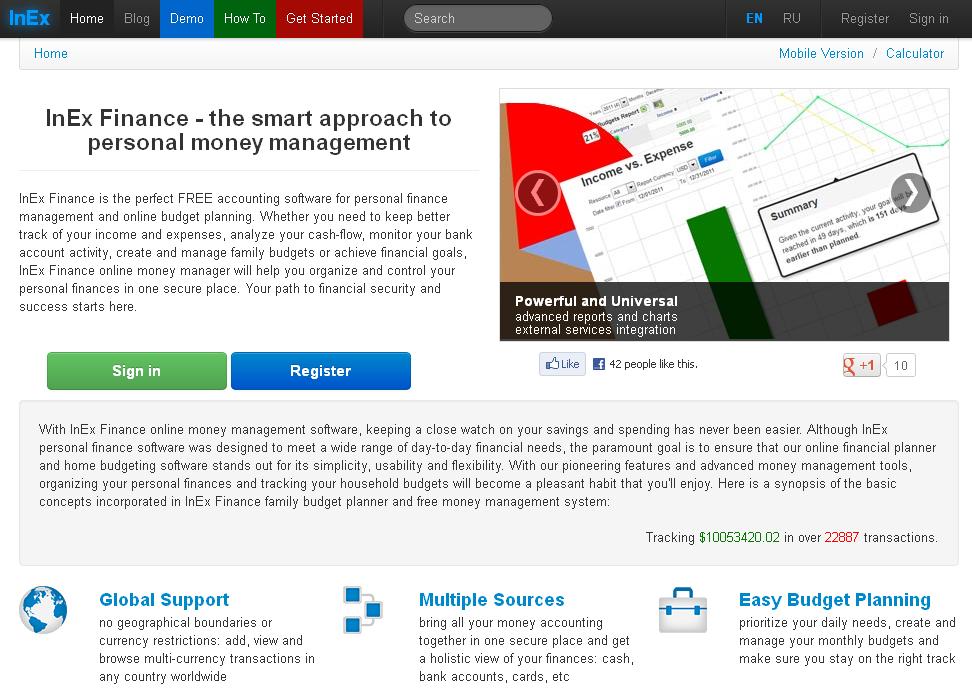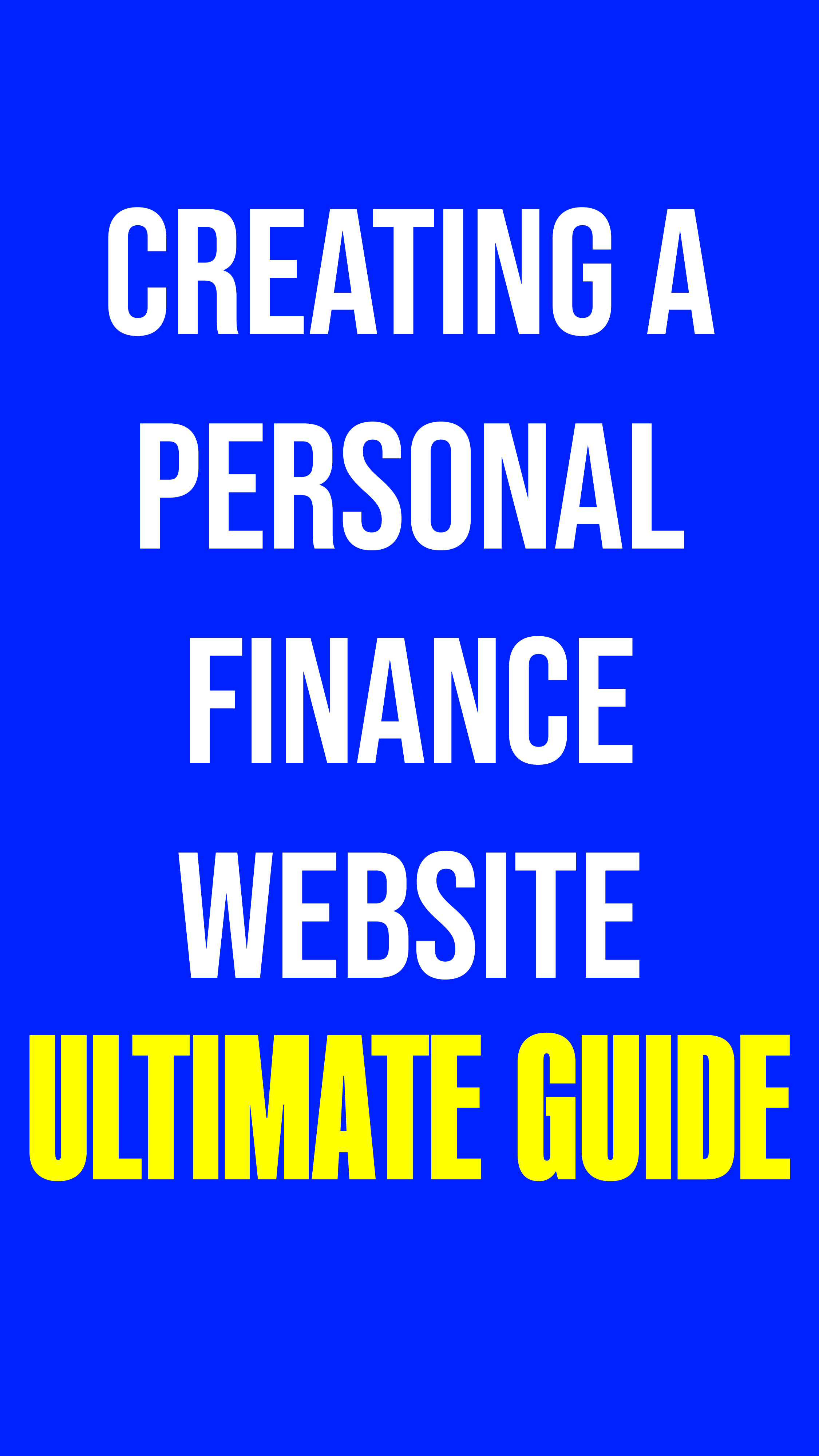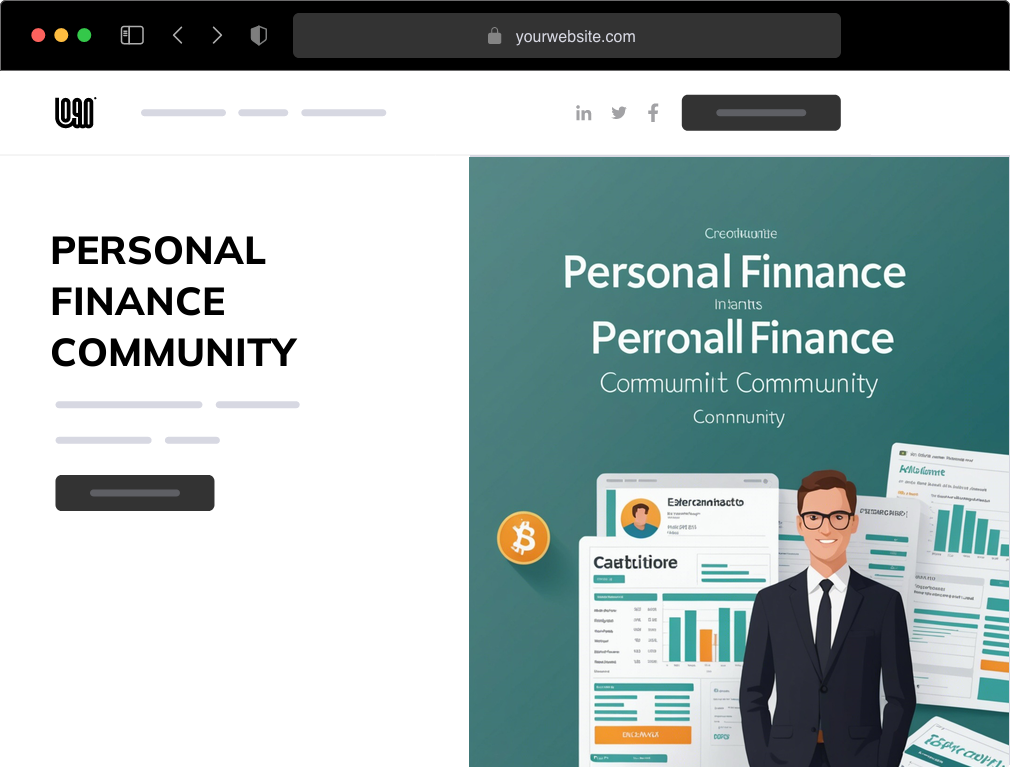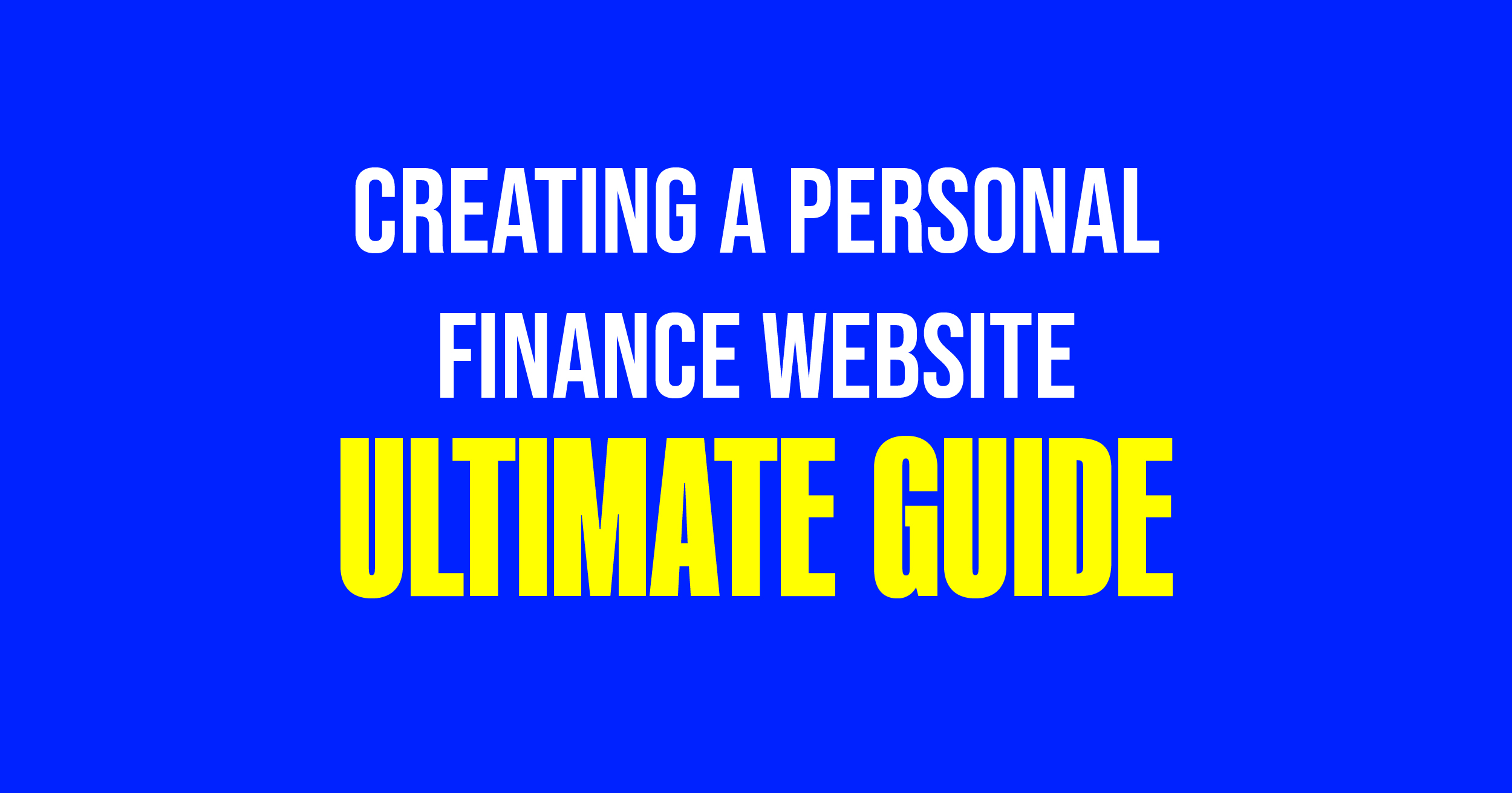To create a personal finance website, choose a niche and build a user-friendly platform with relevant content. Optimize for SEO to attract traffic.
A personal finance website helps users manage their money, save, and invest wisely. Start by selecting a specific niche like budgeting, investing, or debt management. Use a reliable website builder to design a clean, user-friendly platform. Create valuable and engaging content tailored to your target audience.
Incorporate essential features like calculators, budgeting tools, and informative blogs. Optimize your website for search engines with relevant keywords and high-quality backlinks. Regularly update content to keep users engaged and attract more visitors. By following these steps, you can build a successful personal finance website that offers real value to its users.

Credit: www.free-power-point-templates.com
Choosing Your Niche
Creating a personal finance website can be rewarding. The first step is choosing your niche. This decision will shape your site’s content and audience. Focus on what you are passionate about. This will keep your content fresh and engaging.
Target Audience
Identify your target audience early. Knowing who you are writing for will guide your content. Ask yourself these questions:
- Who needs my financial advice?
- Are they young adults or retirees?
- Do they have families or are they single?
Consider their financial goals and challenges. This helps you tailor your content to their needs. Use simple language and relatable examples. This makes your site accessible to everyone.
Unique Selling Points
Define your unique selling points (USPs). These make your website stand out. Here are some ideas:
| USP | Details |
|---|---|
| Expert Advice | Share your personal finance experiences and tips. |
| Tools & Calculators | Provide tools for budgeting and saving. |
| Community Support | Create forums for users to share their stories. |
Highlight your strengths. This attracts visitors and keeps them coming back. Make sure your USPs are clear and visible on your homepage.
Remember, a well-defined niche and clear USPs are key to a successful personal finance website.
Planning Your Content
Creating a personal finance website requires careful content planning. Your content should be valuable and engaging. Let’s explore how to plan your content effectively.
Content Categories
Organize your content into clear categories. This helps users find information easily. Below are some essential content categories for a personal finance website:
- Budgeting Tips: Practical advice on managing budgets.
- Saving Strategies: Ways to save money effectively.
- Investment Guides: Information on stocks, bonds, and mutual funds.
- Debt Management: Tips to manage and pay off debt.
- Financial News: Updates on the latest financial trends.
Editorial Calendar
An editorial calendar helps you plan and schedule your content. Consistency is key to retaining your audience. Here’s a simple example:
| Week | Topic | Category |
|---|---|---|
| 1 | How to Create a Budget | Budgeting Tips |
| 2 | Top Savings Accounts | Saving Strategies |
| 3 | Basics of Stock Market | Investment Guides |
| 4 | Paying Off Credit Card Debt | Debt Management |
Use this table as a guide to maintain a steady content flow.
By planning your content, you ensure your website is informative and engaging. Stay consistent and organized for the best results.
Designing The Website
Designing a personal finance website requires careful planning and creativity. The design should be user-friendly, visually appealing, and functional. Focus on the user experience and ensure the site is mobile responsive. Let’s dive into the key aspects of designing the website.
User Experience
The user experience (UX) is crucial for a personal finance website. A good UX design makes the site easy to navigate and understand. Here are some tips for optimizing UX:
- Use clear and simple language.
- Organize content in logical sections.
- Include intuitive menus and navigation bars.
- Ensure fast loading times for all pages.
- Make sure all links and buttons work correctly.
Creating a positive user experience keeps visitors engaged and encourages repeat visits. A well-designed UX can also help build trust with your audience.
Mobile Responsiveness
More people use mobile devices to access websites. Your personal finance website must be mobile responsive. This means the site should look good and function well on all devices, including smartphones and tablets. Here are some tips:
- Use a responsive design template.
- Test the site on various devices and screen sizes.
- Optimize images and media for mobile loading speeds.
- Ensure buttons and links are easy to tap.
- Keep forms short and simple.
Mobile responsiveness improves user satisfaction and can boost your site’s search engine rankings.

Credit: www.facebook.com
Selecting The Right Platform
Choosing the right platform is crucial for building a personal finance website. Your platform determines your website’s functionality, design, and user experience. This section will guide you through selecting the right platform for your needs.
Website Builders
Website builders are user-friendly and ideal for beginners. They offer drag-and-drop features, making it easy to design your site without coding. Popular website builders include:
- Wix: Known for its flexibility and ease of use.
- Squarespace: Offers beautiful, responsive templates.
- Weebly: Great for simple websites with basic features.
Website builders often provide hosting and domain services. This makes them a one-stop solution. They also offer various templates tailored for finance blogs. You can customize these templates to match your brand. However, they may have limitations in scalability and advanced features.
Self-hosted Solutions
For more control and flexibility, consider a self-hosted solution. This involves using platforms like WordPress.org. Here, you host your website on your own server. This option is more complex but offers greater customization.
Benefits of self-hosted solutions include:
- Complete control over your website’s design and functionality.
- Access to thousands of plugins and themes.
- Scalability for growing your site over time.
You will need to purchase a domain and hosting service. Popular hosting providers include:
- Bluehost: Known for its reliability and customer support.
- SiteGround: Offers excellent performance and security features.
- HostGator: Provides affordable plans for beginners.
Setting up a self-hosted website requires some technical knowledge. You may need to handle updates, backups, and security manually. This option is ideal if you plan to scale and need advanced features.
Setting Up Essential Pages
Creating a personal finance website requires setting up essential pages. These pages help guide your visitors and provide valuable information. Let’s explore the key pages you need to set up.
Home Page
Your Home Page is the first impression visitors get. It should be welcoming and informative. Include a clear headline that tells visitors what your site is about.
- Use a catchy headline like “Master Your Finances Today!”
- Add a brief introduction to your site.
- Include a call-to-action (CTA) button. Example: “Get Started Now.”
Organize your content neatly. Use sections to divide different topics. For instance, have sections for budgeting, saving, and investing tips.
| Section | Description |
|---|---|
| Budgeting | Tips and tools for creating a budget. |
| Saving | Strategies for saving money effectively. |
| Investing | Guides on how to start investing. |
About Page
The About Page tells your story. It’s a place to connect with your audience. Share who you are and why you started the website.
- Start with a brief introduction about yourself.
- Explain your mission and goals.
- Include a photo to make it personal.
Use this page to build trust. Explain how your content can help them manage their finances better.
Highlight any credentials or experiences you have in finance. This adds credibility to your content.
End with a friendly note inviting visitors to reach out. Provide contact information or a contact form.
Integrating Financial Tools

Integrating financial tools into your personal finance website enhances user experience. It helps visitors manage their finances more effectively. By providing valuable tools, you can attract and retain users. Let’s dive into some essential financial tools.
Budget Calculators
Budget calculators are essential for any personal finance website. These tools help users create and manage their budgets. They allow users to input their income and expenses. The calculator then provides a clear overview of their financial situation.
To create a budget calculator, consider these features:
- Income Input: Allows users to enter their income sources.
- Expense Categories: Users can categorize their expenses for better management.
- Visual Charts: Display income and expenses using pie charts or bar graphs.
- Suggestions: Offer personalized tips based on user inputs.
Investment Trackers
Investment trackers help users monitor their investments. They can track stocks, mutual funds, and other assets. This tool provides real-time updates and performance analysis.
Key features for an investment tracker include:
- Portfolio Overview: Show an overview of the user’s investments.
- Real-Time Data: Provide live updates on stock prices and market trends.
- Performance Metrics: Display metrics like ROI and growth rate.
- Alerts: Notify users of significant changes in their portfolio.
Integrating these tools can make your personal finance website more useful. It adds value and keeps users engaged. Happy building!
Monetizing Your Site
Creating a personal finance website is a great way to share your knowledge. But how can you make money from it? There are several effective methods to monetize your site. Let’s explore two key strategies: Affiliate Marketing and Sponsored Content.
Affiliate Marketing
Affiliate marketing is a powerful way to earn money. By promoting products or services on your site, you can earn commissions. Here’s how to get started:
- Join affiliate programs related to personal finance.
- Promote products that match your audience’s interests.
- Include affiliate links in your content.
Many companies offer affiliate programs. Look for high-quality products that offer good commissions. Write honest reviews and include affiliate links. This builds trust with your audience.
Sponsored Content
Sponsored content is another great way to monetize. Companies pay you to write about their products or services. Here’s how to approach it:
- Create a media kit that showcases your site’s stats.
- Reach out to companies related to personal finance.
- Write authentic content that provides value to your readers.
Sponsored posts should always be honest and transparent. Disclose any paid partnerships to your readers. This maintains your credibility and builds trust.
Combining these strategies can maximize your earnings. Keep your content relevant and valuable to your audience. This ensures long-term success.

Credit: 10web.io
Seo And Traffic Strategies
Creating a personal finance website is just the beginning. To reach your audience, you must understand SEO and traffic strategies. These strategies help your website appear in search results. Let’s dive into some key techniques.
Keyword Research
Start with keyword research. This process identifies the terms people search for. Use tools like Google Keyword Planner or Ahrefs. Find keywords related to personal finance. Look for terms with high search volume but low competition.
Here are some keyword tips:
- Use long-tail keywords (e.g., “how to save money on groceries”).
- Focus on specific niches (e.g., “budgeting for college students”).
- Include local keywords if relevant (e.g., “best financial advisors in New York”).
| Keyword | Search Volume | Competition |
|---|---|---|
| Personal finance tips | 10,000 | High |
| Saving money ideas | 5,000 | Medium |
| Budgeting for beginners | 2,000 | Low |
Backlink Building
Backlink building is another critical strategy. Backlinks are links from other websites to yours. They boost your site’s authority and search ranking.
Here are some methods for building backlinks:
- Write guest posts on reputable finance blogs.
- Engage in forums and link back to your site.
- Collaborate with influencers in the finance niche.
Use these techniques to create valuable connections. Strong backlinks can significantly improve your website’s visibility.
Maintaining And Updating
Once your personal finance website is live, the work does not stop. Regular maintenance and updates are crucial. They ensure your website remains relevant and functional. This section will guide you through the necessary steps.
Regular Content Updates
Fresh content keeps your audience engaged. It also improves your search engine ranking. Consider these tips:
- Blog Posts: Write new articles weekly. Share tips and financial advice.
- News Section: Update with recent financial news. Keep your audience informed.
- Case Studies: Share success stories. Show how your advice has helped others.
Use a content calendar. Plan your posts in advance. This ensures consistent updates.
Technical Maintenance
Technical maintenance keeps your site running smoothly. Here are some key tasks:
- Software Updates: Regularly update your CMS. This includes plugins and themes.
- Backups: Schedule daily backups. Protect your data from loss.
- Security Checks: Use security plugins. Scan for vulnerabilities monthly.
Monitor your website’s performance. Use tools like Google Analytics. Identify and fix any issues promptly.
Frequently Asked Questions
How To Start A Personal Finance Website?
Start by choosing a niche and domain name. Create quality content on budgeting, saving, and investing. Optimize for SEO. Monetize with ads, affiliate links, or products. Promote through social media and email marketing.
How To Build Your Own Personal Finance App?
To build a personal finance app, first define its features. Next, design a user-friendly interface. Develop the app using suitable programming languages. Test thoroughly for bugs and usability. Launch and market your app to attract users.
How To Become A Personal Finance Blogger?
Start by choosing a niche within personal finance. Research and create valuable, consistent content. Build a professional blog with SEO optimization. Engage with your audience through social media. Monetize your blog with ads, affiliate marketing, or sponsored posts.
How Much Do Personal Finance Bloggers Make?
Personal finance bloggers can make between $1,000 to $50,000+ per month. Earnings vary based on traffic, niche, and monetization strategies.
Conclusion
Creating a personal finance website is a rewarding endeavor. It requires planning, user-friendly design, and engaging content. Follow the steps outlined to ensure your website meets user needs. Stay updated with financial trends to keep your content relevant. With dedication, your site can become a trusted resource for financial advice.

